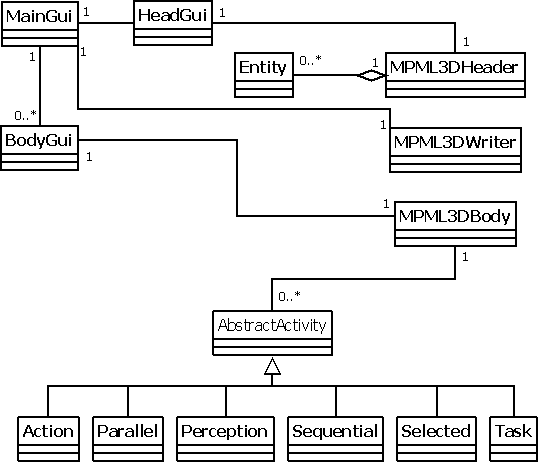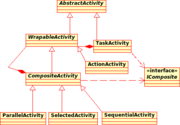PaulDesignStudy
This layout was copied from Janina's design.
For my research project for Cosc366 I developed a simple GUI that would allow a user to construct MPML3D scripts that control Non Player Characters (NPCs) in 3D Virtual World.
I was under pressure to complete the project so I basically threw design out the window and started hacking away. By chance I did implement some parts that were not too smelly but would be unable to tell what pattern they followed.
I will first decide on the requirements for my program and what I would like the program to do. I will give a brief explanation of MPML3D. Then, present and critique my current version to help me to highlight areas I feel require refactoring.
Requirements
- The GUI needs to be intuitive and easy to use.
- The GUI must produce valid lines of MPML3D script.
- The GUI must incorporate all the options under MPML3D.
Constraints
- I cannot change the MPML3D language syntax and semantics or change its code.
MPML3D
MPML3D is a XML-based scripting language to describe the behaviour of computer controlled agents. Although it is not bound to a single platform by design, the current version only supports avatars inhabiting Second Life (SecondLife).It can be extended to OpenSimulator as well (OpenSim). With MPML3D, it is easy to construct agents that can give appealing presentation, including speech, gestures and movement. For a more in-depth explanation of the language goto Manual.
Initial Design
Classes
MPML3DGUI.Classes
NPCCreator –
Class that has the main runs the whole application. Basically creates an instance of MainGui and displays it.
Entity –
An Entity is a representation of a Second Life avatar. It has all the information required to log on to Second Life.
MPML3D.Classes.gui
MainGui –
This creates the parent GUI that the other types of GUI get created and displayed within. This class runs the whole show and creates the HeaderGui and BodyGui objects. When the script is ready to be written this class creates an MPML3DWriter and passes it the HeaderGui and BodyGui to be written to a script.
HeaderGui –
This GUI is used by the user to create the header of the script. It holds a list of Entities which are used to write to the script and a list of strings that have are used to write out the External perceptions created. This class also creates an instance of MPML3DHeader.
BodyGui –
The user uses this GUI to create the body of the script. This class creates an instance of an MPML3DBody.
MPML3D.Classes.Writer
MPML3DHeader –
This class has all the data required to write the header of a valid MPML3D script. It has a list of entities and a list of external perceptions.
MPML3DBody –
This class has all the data required to write the body of a valid MPML3D script. It has a list of activities that can also have a list of activities nested with in it.
MPML3DWriter –
This class gets the MPML3DHeader and MPML3DBody classes from the MainGui and writes all the data from the header and body to a file.
MPML3D.Classes.activities
These classes inherit from the AbstractActivity class. Each activity contains the data to create the required lines of valid MPML3D code. Each activity performs a unique action on the avatar.
AbstractActivity
ActionActivity
ParallelActivity
PerceptionActivity
SequentialActivity
SelectedActivity
TaskActivity
For more information of what each activity does please refer to the manual Manual.
Walkthrough
When first running the program the MainGui interface is presented. From here the user can create a new script or edit an existing script. Once an option is selected a HeaderGui window is opened and the user can create entities and external perceptions that they require. Once finished the user clicks the “Create body” button. This calls a method within the MainGui that opens a BodyGui. The user can then enter the activities that control the entities here. When finished the user clicks “Write script” where a file browser opens and the user can navigate to the required folder, as well as naming the script.
Design Critique
I feel there are a lot of things that can be improved with in this design.
Specific design maxims that are violated by the initial design:
- No-op overrides/Design by contract/Liskov Principle: Some of the subclasses of AbstractActivity donot require some of the super classes methods and have been overwritten with a stub that says this method not required.
- Coupling: The Gui and backend are strongly coupled making it hard to create a new Gui for the system.
- Data class smell / Eliminate irrelevant classes:A few of the subclasses of AbstractActivity do not require any additional functionality.
- Avoid downcasting / Beware type switches: I sometimes need to check what activity I have and cast them to a type. This is ugly.
Aims for my first design
- Create a MVC pattern
- Use a composite design pattern for AbstractActivity and subclasses
- or try and remove the no-op methods
AbstractActivity and subclasses.
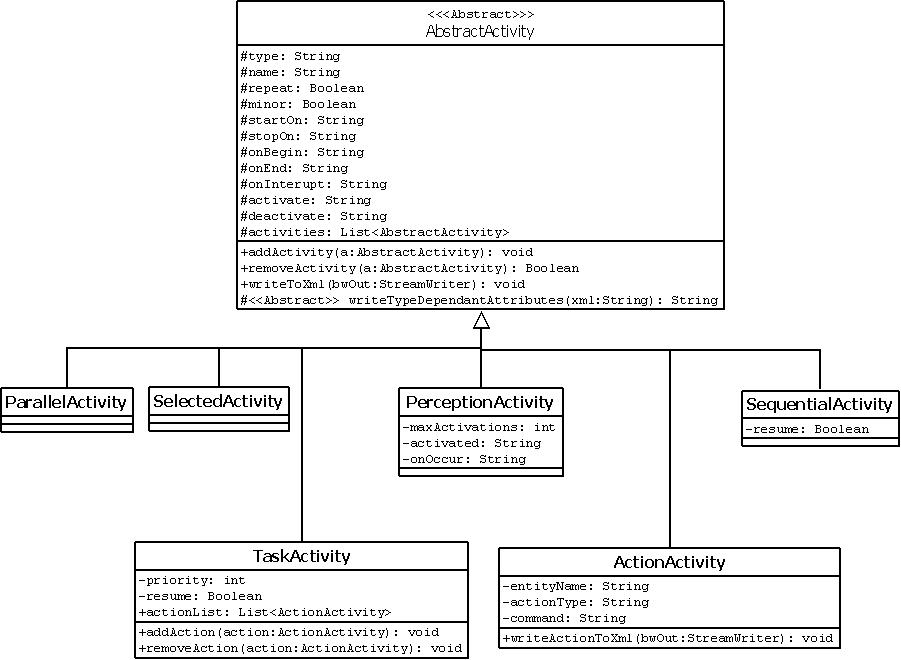
The parallel and selected activity classes have no additional functionality to the super class. The ActionActivity cannot contain any other activities so the add remove activity method from the super are no ops. My first guess is to use a Composite design pattern but I feel as though I need to move some of the classes around. On closer inspection the PerceptionActivity should not be here as I misread the information on what a perception is so I will move this class to a new hierarchy with two other classes.
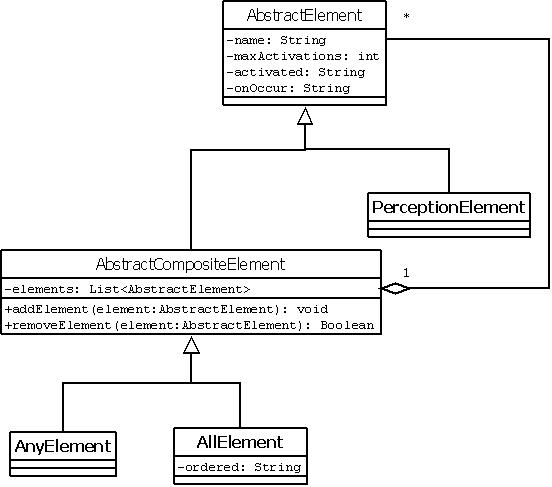
By following a similar pattern for the AbstarctActivity hierarchy I run into the problem of what to do with TaskActivity as it can add Activites to its list but cannot be part of any other activities list.
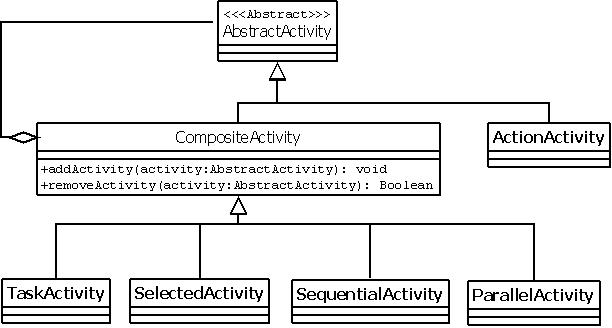
At Paul's request... I came up with an adjustment to the design. --Matthew Harward 01:48, 6 August 2009 (UTC)
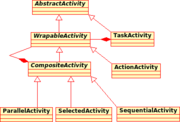
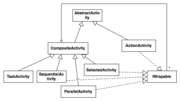
Thanks to Michal, Mathew and class for there input here is the final design that I choose I thought I was close to a solution with my AbstractElement solution but by adding the interface wrapable it helped to fix the problem with task activity with it being able to hold other activities but could not actually be wrapped.
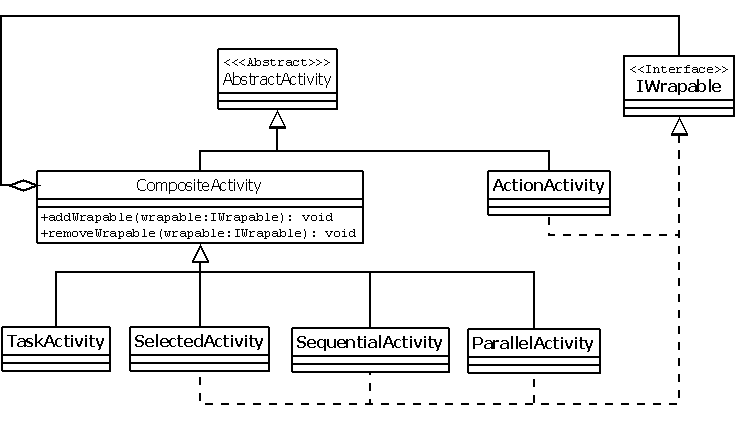
Model-View-Controller
The model consists of the MPML3DHeader and MPML3DBody. The view consists of a all encompassing starting GUI that can has a HeaderGui and a BodyGui. For now I will not concentrate on where the heck the MPML3DWriter should be as I am as of yet undecided.
Will a clear cut between model and viewer i now need to create a controller and decide how to design it.
Followed design principles
There are several design principles that I used to arrive at my final design. While I followed many design principles in my design, there were a few principles that strongly influenced the design decisions I made. In this section, I will describe which design principles I used in particular during my redesign and why I chose to use those principles.
- One responsibility rule / Single responsibility principle / Distribute system intelligence / Separation of concerns: In my original design, the EncapsulationAnalysisVisitor class contained a number of separate responsibilities, making it large and unmanageable. One of my main goals for this design was to break up this large class into classes that made more sense and had a single responsibility. Over the course of redesigning the system, I recognized more and more responsibilities that needed to be separated into distinct classes. Originally, I decided to have an Analyzer class (similar to the MetricCalculator class in my final design) that would analyse the model and write out the results to file. I realized that writing results out to file was a very separate responsibility from analyzing the model and therefore separated this responsibility into a separate class which eventually became the ResultWriter class in my current design. The Analyzer class also originally decided which parts of the model were relevant and should be analyzed but again I saw this as a distinct responsibility and separated it into the AccessStrategy and MemberStrategy classes. Overall, I think that following the Single responsibility principle greatly improved my design. It lead to small and manageable classes that are easy to understand and have a clearly defined responsibility.
- Avoid downcasting: My original design included a number of downcasts that I used to make decisions about what course of action to take. Instead of downcasting, I should have subclassed instead. In this new design, I carefully avoided including any downcasts. Whenever I felt tempted to downcast, I carefully thought about introducing a new subclass instead. I think that overall following this rule has made my code simpler and less error prone. It has introduced several new subclasses which would have been combined into one class originally.
- Model the real world: I tried to model the real world wherever possible, especially when creating the hierarchy of program entities. I thought about the parts of a Java program and how they are related to each other and tried to model that. The entities of a Java program participate in a number of complex relationships, some of which I didn't want to or need to model. If this was the case, I simply left them out of my design according to You ain't gonna need it. However, I still tried to keep the simplified model as close to the real concepts in Java programs as possible. Another place where I used this principle was when thinking about metrics measurements. I originally wanted to just put the value of the measurement and the name of the metric being measured into the Measurement class but later decided that in reality a measurement contains at least three vital parts of information: the part that's being measured, the metric being used and the value of the measurement. Again, I followed You ain't gonna need it and decided that modelling metrics and different metrics values and scales was beyond the scope of my project. I therefore included the value of the measurement and the name of the metric as a simple String in the Measurement class. However, I added the reference to the entity that the measurement applied to in order to properly model the real world.
- You ain't gonna need it: My aim for this project was to build a tool that could extract metrics data from a JST model of a Java program. Building a general metrics framework to accommodate all metrics would have been useful but quite complex. With metrics, there are many different concepts to consider including different scales, different valid values etc. I decided that I was unlikely to need any of this for the purposes of my Honours project and since it is relatively unlikely that anyone else will use my program in the future, I decided to stick to what I needed for my Honours project rather than modelling metrics in general. This greatly simplified my design. As described above, this was the reason why I decided to make the Measurement class the way it is, containing a String for the value of the measurement and for the name of the metric being measured rather than modelling these concepts as separate classes according to You ain't gonna need it. I also used the You ain't gonna need it principle when creating the simplified model of the Java program. JST is a very complete and complicated model of a Java program. The whole reason why I chose to create a simplified model that my MetricCalculators could analyse was because I wanted to simplify my code. Some of the code I had previously that directly accessed parts of JST was quite complicated and I wanted to hide this complexity from as much of my system as possible. The model of the program I constructed as an alternative to JST for my MetricCalculators is arguably very incomplete but sufficient for my purposes. I decided to model just as much as I needed for my purposes rather than recreating a complete model that would be similar in complexity to JST anyway because I knew I wouldn't need it.
- Favor composition over inheritance: I used this design principle when deciding to introduce the AccessStrategy and MemberStrategy classes. Originally, the MetricCalculator was going to calculate the metrics and also extract the relevant program parts to analyse from the model of the program. I decided to subclass AccessMetricCalculator and MemberMetricCalculator so that the subclasses could decide to either extract field information or method information from the program model. However, Favor composition over inheritance and the Single responsibility principle convinced me to create the Strategy hierarchies rather than introducing subclasses. The reason for this was that I felt that composition would make my design a lot more flexible and easier to extend. I also felt that extracting the relevant parts from the model and calculating metrics were two separate responsibilities that should be in distinct classes.
- Many to many association idiom: I used the many to many association idiom as part of the relationship between AccessibleMembers and ExecutableBlocks. An AccessibleMember may be accessed from many ExecutableBlocks and an ExecutableBlock may access many AccessibleMembers. Rather than having a simple many to many association directly between ExecutableBlock and AccessibleMember, I included the Access class as an in-between concept. This turned the many to many association into two many to one associations and removed the direct dependency between AccessibleMember and ExecutableBlock.
Design patterns used
- Strategy: I used the Strategy design pattern to enable MetricCalculators to use different strategies (AccessStrategy, MemberStrategy and their subclasses) to extract relevant parts of the program to analyse. This means that a single MetricCalculator object can first be used to collect metrics about fields and can the be reused to collect data about methods. The strategy for retrieving the parts of the program can be changed at runtime if desired. Using the Strategy pattern here also makes the design very flexible, since it is easy to add new Strategies without affecting the MetricCalculator hierarchy in any way. Apart from allowing the program to change the strategy for retrieving the program parts that should be analysed at runtime, I also used the Strategy pattern to separate the algorithm for retrieving program parts from the analysis and metric calculations.
- Builder: I used a Builder design pattern to encapsulate the building of the simplified program model (Builder class). This process is relatively complex and contains a number of separate steps. Each part of the program needs to be built separately. At the end of the building process, accesses to program parts need to be resolved and Access objects built. I could have put this behavior into the JSTModelVisitor class but I decided that visiting the JST model and building a simplified model really were separate responsibilities and therefore introduced the Builder class. I also decided to do this because it is possible that the program model could grow more complicated in the future and the amount of code in the Builder could grow. If this happens and the code for building the model was in the JSTModelVisitor, this class would soon become unmanageable.
- Visitor: The Visitor design pattern (JSTModelVisitor class) is an obvious choice when working with JST as it represents an easy way to visit the JST model and extract information from it. A constraint on my project was that I could not modify the code in JST, meaning that I could not add the behavior I needed to JST classes. Therefore, using a visitor to walk through the model was an attractive alternative. Because JST's interface already provides a lot of methods to extract information from JST, making a visitor to extract relevant program parts and build a simplified model of the program was easy to do.
- Facade: Early on in the redesign, I decided to create a facade interface to JST that would be easier to use to calculate metrics than the relatively complicated JST interface. While the JST interface provides a lot of useful methods, a good understanding of the complex structure of JST is required to use it. In addition, some things that my program needs to do as part of its calculations is quite difficult to do using the JST interface and requires some complex code. The simplified model of a Java program that the redesigned program builds up provides a simpler interface to JST. Though it contains a number of different classes unlike the traditional Facade design pattern, it can still be seen as a different implementation of the Facade pattern because it also hides a complex subsystem interface.
Design conflicts
At some point during the redesign process, I realized that the problem I was trying to solve was relatively difficult because there were a number of opposing design forces acting on my design. This meant that I had to weigh up different options and their advantages and disadvantages before deciding which design principle to follow and which to break. In the following section, I describe some of the specific design conflicts that I had to deal with and justify the decisions I made that lead to my final design.
Keep related data and behavior in one place to me is a fundamental maxim of object oriented design. A big part of OO design to me is about clumping up data and behavior that belongs together and separating data and behavior that don't belong together.
However, there are times when we deliberately separate related data and behavior. For example, in the Frogs design, many in the class agreed that it was bad for a Frog to be able to export itself. This is despite the fact that the exporting to XML behavior is closely related to the Frog and needs to make use of the Frog's data. Separation of concerns and the Single responsibility principle are design maxims that urge us to make this separation because exporting is arguably a very different responsibility from the Frog's usual responsibilities.
A similar conflict occurred in my design study. The question was whether to separate the model of the Java program from the metrics calculations that are performed on it or to keep the behavior together. I weighed up both options.
Combining the metrics calculation behavior and the program model would be a good idea because related data and behavior would be kept together and would lead to Behavioral completeness. It would mean that an entity could calculate its own metrics. This would be in line with Tell, don't ask and the Law of Demeter because we could simply tell an entity to calculate a metric about itself rather than asking it for some data so we can do the metric calculation somewhere else. On the other hand, polluting the program model with metrics calculations seems like a bad idea, especially if many more metrics may be added later on in the development process. The model would get overloaded with metrics methods that are barely related to each other and the classes in the program model could conceivably grow very large and unmanageable.
Separating the metrics calculations from the program model itself would be a nicer Separation of concerns and would allow new metrics to be added more easily without affecting the program model. However, this would mean that accessors to get data from the program model would be hard to avoid. Rather than adhering to Tell, don't ask and the Law of Demeter, metric calculators would be forced to ask the model for data to use in metrics calculations.
In the end, I decided that metrics calculations and the program model were very different and should be separated according to Separation of concerns and the Single responsibility principle. I felt that the benefits of being able to easily add new metric calculators without having to change the model outweighed the disadvantages of having to add accessors to the program model.
Another place in my design where I was forced to separate related data and behavior was when visiting the JST model. It was not possible to change the JST classes as part of my project and I therefore used a Visitor pattern to extract data from the JST model to construct a simpler program model. This required my to use accessors defined in the JST interface which is in conflict with Tell, don't ask and the Law of Demeter. However, this breach makes sense for the same reason as described above.
You ain't gonna need it versus consistency
As explained above, I was influenced by You ain't gonna need it when designing the simplified program model. I decided to leave out relationships and program entities that I knew I wouldn't need for my Honours project. This decision overall lead to a much simpler and cleaner design.
However, I included some model parts that I was not sure I would need. ExecutableBlock for example represents a block of code between two matching braces. At this stage, I don't think that I will need to use this class for my metrics calculations as part of my Honours project. Nevertheless, I included it in my final design.
At different points of the redesign, I decided to include or exclude this class. I was tempted to exclude it because I didn't think I would need it. As a result, the class doesn't contain a lot of code and definitely smells like a lazy class (Lazy class smell). In addition to this, You ain't gonna need it would definitely advice me to exclude the class.
However, I decided to include it in my final design for consistency reasons. The Access class represents an access to a field or method from an ExecutableBlock. Because my program heavily uses accesses, I felt that even though I don't currently use ExecutableBlock, it is a sufficiently important concept in the program to justify including it. It didn't seem consistent to model only one half of the Access concept and ignore the other half. For the sake of consistency and Model the real world, I therefore decided to keep it in my final design.
Data class versus model the real world
Similarly to my decision to include ExecutableBlock in my final design, I also decided to include the Measurement class to represent the concept of a single metric measurement. This class contains very little useful behavior other than accessor methods and can therefore be seen as a data class. This invokes the Data class smell and Lazy class smell and is also classed as an anti-pattern (Anemic Domain Model).
However, I decided to include the Measurement class in my design despite these problems. I made the same decision for ExecutableBlock and some other small classes in the program model hierarchy. The main reason I decided to do this was to Model the real world. I felt that these concepts were sufficiently important concepts in my domain that I should model them. Since they are all important concepts, it is very possible that they will be used more heavily in the future. I felt that if I excluded these important concepts from my design, my design would become harder to understand and relate to the domain I was modeling. In addition, I thought it was quite likely that I would just have to introduce those classes anyway later on in the development process. Therefore, despite the fact that this violates several design heuristics, I decided to include these classes for this sake of clarity and consistency.
Parallel hierarchies and lazy classes
Creating a simplified model of JST essentially creates a parallel hierarchy. Some of the concepts from JST are currently modeled in the simplified program model while others aren't. There is a correspondence between parts of the simplified model and the JST model and parts of the simplified model actually contain the part of the JST model that they correspond to. For example, a ClassOrInterface object contains the JST UserType that it corresponds to.
At the moment, the simplified program model hierarchy is relatively simple but it is possible that as more and more functionality is required for new metrics it will grow into something similar in size and complexity as JST. If this happens, we will definitely have two parallel hierarchies.
When I made the decision to create the simplified model hierarchy, I took several factors into account. The main reason for wishing to create the simplified model in the first place was that I wanted to provide behavior to metrics calculators that made it a lot easier to calculate certain metrics. Some of the information that is needed for current metrics calculations is not straightforward to extract from JST. Therefore, I wanted to hide this complexity from metrics calculators. Some other metrics that could be useful in the future like cyclomatic complexity would be similarly difficult to implement using the current JST interface since it would likely be necessary to get certain information from complex program parsetrees. Hiding this complexity in a facade-like layer was the main reason that I considered creating the simplified model.
I was well aware of the danger of the simplified model growing into a parallel JST hierarchy when I made my decision. While I think that it is conceivable that the "simplified program model" could grow significantly more complex to accommodate different metrics, I still think that the simplified model would make metrics calculations a lot easier, since it could contain methods that provide the information needed by metrics calculators and hide away the complexities of JST. Therefore, I believe that even if the hierarchy gets more complex, it would still be useful because it would continue to provide a more suitable interface for the required task than JST. In addition, the creation of the simplified model is hidden away in the Builder class. Even if the simplified model grows into a parallel hierarchy to the JST hierarchy, the Builder could hide this fact relatively easily, making the rest of the program unaware of and unaffected by this issue.
The other issue with the simplified model hierarchy is that some of the classes currently don't contain a lot of code apart from some relatively simple accessor methods. As such, there is a definite Lazy class smell present in some of the classes. This would disappear if more methods were required by metric calculators that could be provided by the simplified model. Overall, I decided that the benefit of having the simplified model outweighed my concern about some of the lazy classes. in addition, as explained above, some of these classes were the result of modeling the real world.
Hide data within its class
Riel tells developers to Hide data within its class, a clear indication that he sees the class as the encapsulation boundary. Part of my research focuses on the question on where the Encapsulation boundary should be and as a result I am strongly aware of the differences between object and class encapsulation. I very much want to use object encapsulation in my code and therefore sometimes break Riel's heuristic of hiding data within its class.
However, this does not mean that I make my data public. Instead, I sometimes make data in superclasses protected, which also conflicts with Riel's heuristic Avoid protected data. By default, I will make my instance variable private. However, when subclassing or planning to subclass a particular class, I often make fields protected and access them directly from the subclasses. The reason why I don't make all data protected by default is that I still feel a little uneasy with the protected access mechanism in Java because it also gives access rights to all other classes in the package. As such, I try to find a middleway between making data protected and private.
Extensibility of the design
I put a lot of thought into making my design as easy as possible to extend because I know that I will need to add new features in the near future as part of my Honours project. Below, I describe how my design could be extended.
Adding new model parts
The current program model is a greatly simplified version of the JST model and only includes classes and interfaces, methods, fields and blocks. Therefore, it is very possible that this model may need to be extended in the future. Extending the model requires a certain amount of knowledge of JST and Java programs in general.
To extend the model with a new concept such as constructors for example, one would first need to create a new class for the new concept. This class needs to be connected to the rest of the model hierarchy in a way that makes sense. For constructors for example, we would create a Constructor class and make it a subclass or AccessibleMember because it can be accessed from a block of code.
The next step would be to decide how to add the new concept to the containment hierarchy of the model. Currently, the program contains classes and interfaces, which contain methods, fields and blocks of code. For constructors, we would decide to add a containment relationship so that classes contain constructors.
In addition to the containment relationship, we may decide to add other relationships between program entities.
We would then need to modify the Builder class to allow constructors to be built correctly. This would include making an addConstructor() method which creates a constructor object and adds the constructor to the current class.
Finally, we would need to modify JSTModelVisitor so that it visits the corresponding concept in JST, for example ConstructorDecl in the case of our constructor example. This method would simply call the Builder's addConstructor() method to create a Constructor object.
Obviously, it depends to what concept needs to be added to the model and which relationships should be modeled as to how easy or difficult this process is.
Adding new metric calculators
If we want to calculate a new metric, we would simply have to implement a new MetricCalculator. This is easy to do by simply subclassing MetricCalculator and implementing the necessary functionality for calculating the new metric.
Depending on which parts of the program model the new metric applies to, we may have to modify the model of the program as described above. For example, if we wanted to add a metric that tells us which classes a field or method is visible from, we would not need to add new concepts to the model. On the other hand, if we wanted to calculate cyclomatic complexity, we would have to add concepts for statements, or at the very least the relationship that describes how blocks of code (e.g. method bodies) contain other blocks of code (e.g. if-statements or while-loops). This would require some changes to the program model.
It may also be necessary to update the model to add methods that are needed for the metrics calculations. For example, for cyclomatic complexity, we need to be able to find out if a block is an if-statement or a while-loop, something that is not easy to do using the JST interface. Instead, we would write a method to do this in the ExecutableBlock class which would go and analyse the JST model to retrieve the necessary data.
Once we have written the MetricCalculator and updated the model as necessary, we need to write one or more strategies to extract the relevant program parts to analyse from the model. This is easy to do as long as the correct methods have been added to the model as described above.
Adding new result writers
ResultWriters write the metrics measurements out to file. In the current design, there is only a simple TextWriter, which writes the results to a plain text file.
In the near future, I want to add an XMLWriter that writes measurements out to XML. Adding a new ResultWriter in this way is easy to do. The ResultWriter class needs to be subclassed and the two abstract methods it contains need to be overridden for the new file output formal. The first method that needs to be overridden is the writeOutHeader(String header) method which simply writes a header for a set of metric measurements out to file. The second method is the writeOutResults(List<Measurement> measurements) method which writes out a list of metric measurements.
Summary
Final Layout
Review
- Single responsibility principle / One responsibility rule : This is the main reasoning for having a MPML3D header, body and writer. Each one of these classes takes care of the 3 distinct areas of a MPML3D script.
- Keep related data and behavior in one place: Also for the above reasonings.
- Avoid no-op overrides : By using a variation of the composite design pattern and using a wrapable interface the problem of no ops has been addressed.
- MVC : Adding the MVC pattern allows the backend and gui to be totally uncoupled making it easier to create a new front end gui.
- Open closed principle : By using inheritance for the activitys and elements it is easy to add new members to these hierarchys.
Conclusion
I feel the new design has a more pleasing or less smelly feel to it. With the use of the MVC the whole system just looks a lot less coupled. As well as the
